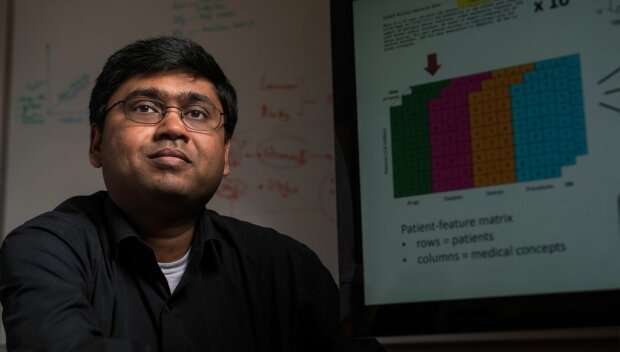Data-powered consult service shown to help doctors diagnose illness, guide treatments

Researchers at Stanford Medicine have breathed new life into old electronic health records to help doctors stumped by tough cases.
They created the Clinical Informatics Consult Service, a resource for physicians seeking insights into illnesses that are challenging to diagnose and treat. Unlike a standard physician-to-physician consultation, doctors can tap into findings from thousands, and sometimes millions, of cases to find information that might help them understand their patients’ cases.
In a new paper published Sept. 15 in NEJM Catalyst, Nigam Shah, MBBS, Ph.D., professor of medicine and of biomedical data sciences, and his team describe the first 100 of those consults, which took place in 2017 and 2018, documenting diagnoses, enhanced patient care and even cases in which patients’ courses of treatment changed entirely.
“Medicine has been dreaming about doing this for 50 years,” said Shah, who led the study.
The first known effort to search a library of patient records for medical answers dates to 1972. But acquiring data was expensive and hard to do en masse in the 1970s. Only in recent years has access to enormous troves of patient data, deidentified so patients’ privacy is protected, become available. “It’s the first time we’ve been able to do this on a large scale for multiple specialties,” he said.
Shah is the senior author of the paper. Research scientist Alison Callahan, DPhil, and adjunct clinical assistant professor Saurabh Gombar, Ph.D., are the co-lead authors.
Querying the database
The Clinical Informatics Consult Service was available to Stanford doctors during its research phase from 2017 to 2019. It’s fueled by a powerful search engine created by a team researchers who sort through massive datasets of health records that have been wiped of identifying information to protect patient privacy. Using information like medical histories, vital signs, lab results, prescriptions and more, the researchers parsed the data to find other cases to inform questions they receive about incoming patients.
When a doctor submitted a question, the team translated the request into code that a search engine would process. The search engine then scoured the deidentified medical records for matching information, such as medical histories, vital signs, lab results and prescriptions. It winnows the results until only individuals who are medically similar remain.
Then the data analysis. They parsed the records’ specifics, such as disease history or the effects of different prescriptions, and finally, they summarized the findings. The team typically returned results to doctors within 72 hours.
For the study, to ensure the results from the searches were reliable, Shah’s team queried two separate datasets—one from Stanford Medicine and one from an external, commercially available source. “We essentially did two consultations for every inquiry as a measure of dependability; we wanted to see how well the results from each database aligned,” said Shah. “The bad news is the consult results didn’t line up 100%, but the good news is that agreement was around 70%, which is about how often results from randomized trials agree.”
The consults turned up all sorts of information: A deep dive into sleep apnea treatment revealed that those who used continuous positive airway pressure, or CPAP, to help them breathe at night were more likely to experience cardiovascular, neurological or endocrinological complications compared with those who had surgery to treat sleep apnea.
In more than one instance, the findings from the consult guided the treatment regimen for a patient. In one case, a child suffered from mononeuritis multiplex, a condition that inflames the nerves of the hands and limbs. “This condition is very rare in children, and the doctors had initially planned to do a handful of somewhat expensive and invasive tests—spinal taps, MRIs and such—to try to figure out a course of treatment,” Shah said. The consult uncovered more than 100 similar cases that showed children with this condition were effectively treated with a steroid. “When the health care team saw the results, they decided to hold off on the extensive tests and opted for this treatment option instead.” The child recovered with no complications found during a follow-up visit.
Beyond the clinic
Nearly all physicians who have used the service gave positive feedback. “We sent a debrief survey to every physician who we worked with and asked them what the chances were that they would refer the consult service to their colleague. Likelihood to recommend was nearly 100%,” Shah said.
Another notable success, Shah said, is that findings from four of the 100 cases were published separately as distinct manuscripts. “These findings were in respected journals,” he said. “It’s a nod to the fact that the findings and data that arise from these consults—even though they’re done quite quickly—are of a high caliber and pass the peer review bar.”
Outside of serving clinical consultations, Shah hopes that this work can fill gaps in clinical trials or contextualize medical guidelines for diverse groups of people. The 10-year cardiovascular risk estimator, for instance, a commonly used tool to predict someone’s risk of having a cardiovascular problem over the next decade, fails to account for much of the U.S. population.
“That risk estimator is based on data that did not include Asian people, and there’s evidence from research conducted at Stanford that it’s not perfectly calibrated for women,” Shah said. “Mining EHR data to try to fill those gaps doesn’t completely obviate the issue of incomplete data, because if someone is not receiving health care their information will not be recorded, but it does provide more representative data from real-world patients.”
Source: Read Full Article
